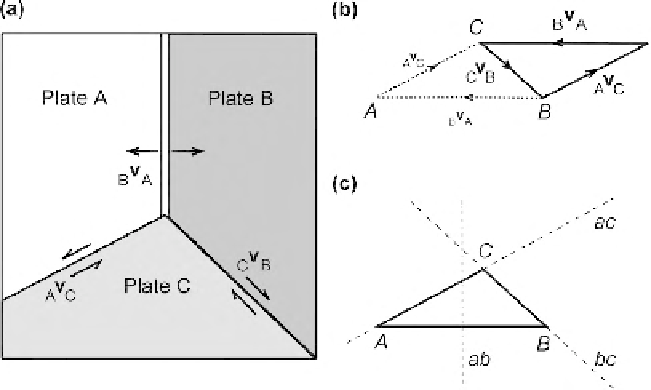Geoscience Reference
In-Depth Information
Figure 2.18.
Determination of stability for a triple junction involving a ridge and two
transform faults, FFR, (a) The geometry of the triple junction and relative velocities.
(b) Relative- velocity triangles (notation as for Fig. 2.17(b)). (c) Dashed lines drawn
onto the relative-velocity triangle as for Fig. 2.17(c). This triple junction is stable if
point C lies on the line ab, or if ac and bc are collinear. The first condition is satisfied
if the triangle ABC is isosceles (i.e., the two transform faults are mirror images of
each other). The second condition is satisfied if the boundary of plate C with plates A
and B is straight.
junction would be stable) if bc were parallel to AC or if ab and ac were parallel.
This would mean that either the relative velocity between plates A and C,
A
v
C
,
was parallel to the boundary between plates B and C or the entire boundary of
plate A was straight. These are the only two possible situations in which such a
TTT triple junction is stable. By plotting the lines ab, bc and ac onto the relative-
velocity triangle, we can obtain the stability conditions more easily than we did
in Fig. 2.15.
Figure 2.18 illustrates the procedure for a triple junction involving a ridge and
two transform faults (type FFR). In this case, ab, the line representing any motion
of the triple junction along the ridge, must be the perpendicular bisector of AB.
In addition bc and ac, representing motion along the faults, are collinear with BC
and AC. This type of triple junction is stable only if line ab goes through point C
(both transform faults have the same slip rate) or if ac and bc are collinear (the
boundary of plate C is straight). Choosing ab to be the perpendicular bisector of
AB assumes that the ridge is spreading symmetrically and at right angles to its
strike. This is usually the case. However, if the ridge does not spread symmetrically
and/or at right angles to its strike, then ab must be drawn accordingly, and the
stability conditions are different.

